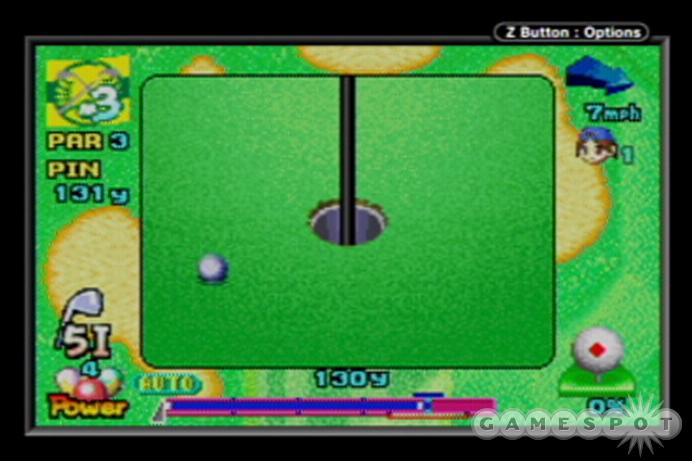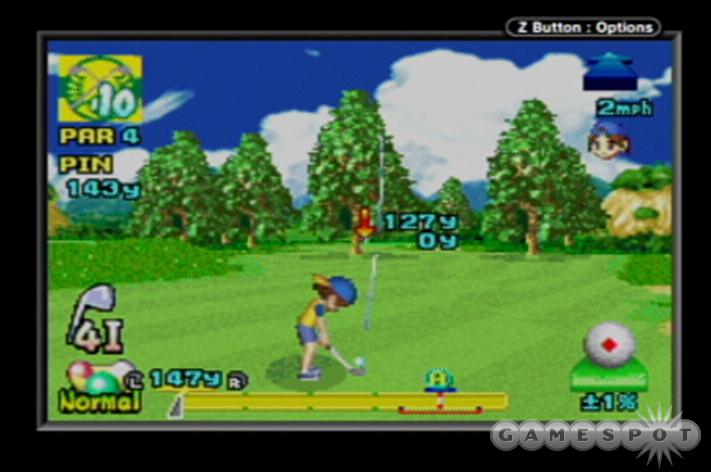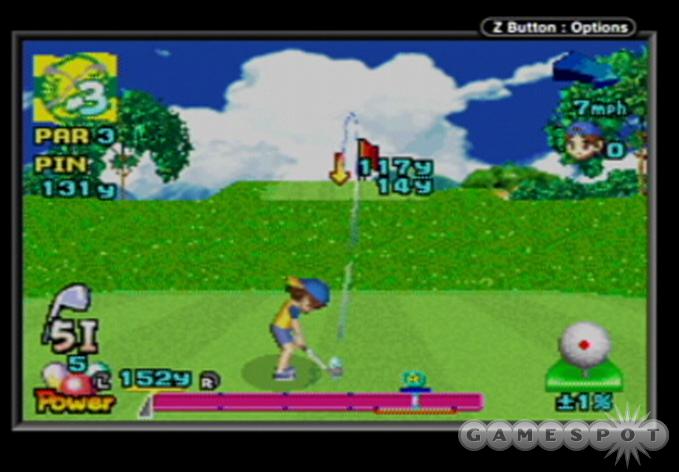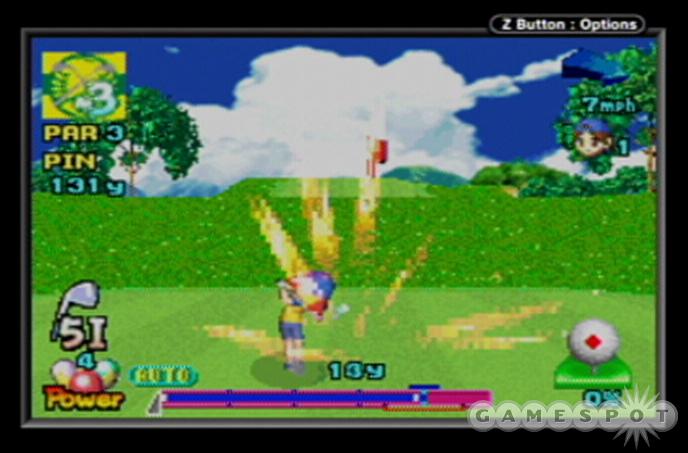When you combine Mario and sports, you're pretty much always guaranteed something a little offbeat. Those who have been following the Mario Golf games since the N64 shouldn't be surprised that Camelot's new Mario Golf: Advance Tour offers a pretty solid game of golf but with a few twists--the most prominent being its inclusion of a story mode that whiffs of a 16-bit role-playing game. The addition of light role-playing elements to the otherwise standard golf gameplay doesn't always mesh particularly well, but the game is otherwise put together well enough that such minor design peculiarities are easy to overlook.

While most golf games would suffice with a career mode, Mario Golf: Advance Tour takes it a step further with a full-on RPG-style story mode, complete with precast characters and lots of dialogue. Coming from another developer, this choice would seem especially peculiar, but considering that Camelot was also responsible for the Golden Sun games, which were themselves an homage to the 16-bit RPGs of yore, it kind of makes sense.
The game follows two young players, Neil and Ella, as they spend a summer at the Marion Country Club improving their games, entering competitions, and eventually facing off with the best golfer in this strange, little world: Mario. You'll be actively playing as either Neil or Ella, with the off-character being artificial intelligence-controlled during doubles matches. Winning tournaments, competing in match games against pros and other players, and successfully completing some of the skill-specific training camps that are scattered throughout the game will net you experience points, which you can distribute at your discretion between both Neil and Ella. One of the more curious design decisions even lets you give experience points you earn during singles play to either or both characters.
It's a little odd that you don't play as Mario in the story mode and that the story mode reserves the Mushroom Kingdom-themed courses, which feature much Mario-inspired topography and all forms of bizarre objects and obstacles that both help and hinder your game, for pretty late in the game. There's not a lot of depth to the actual story, and you get a little sense of disconnect between it and the gameplay. However, the story mode goes far to give some context to your matches, and it helps give the game a distinct personality. Still, if you stripped out all of the wandering around and chatting with other players that you'll do in this mode, it would stand nicely as a full-featured career mode in a more traditional golf game.

Playing the story mode is essential to getting the most out of Advance Tour, because it unlocks lots of players and courses in the quick game mode, which houses a broad selection of gameplay types for one-off matches. There are some fairly traditional options here, including match, stroke, and doubles games, as well as a near-pin contest and a speed golf mode, where you're scored on how quickly you can get through a course rather than the number of shots you take. The club slots mode gives you a small, random selection of clubs to play with, challenging your ability to come up with creative solutions on the course. Go-Go Gates is a good 2D alternative to the Ring Shot mode found in Toadstool Tour, challenging you to put all of your shots through a series of gates. The more straightforward modes seem to have a little more lasting appeal here, but the variety makes the whole package further appealing. Also, if you want to get your Mario fix in a hurry, you'll want to head for the quick game mode, which lets you play as Mario, Peach, Yoshi, or Donkey Kong right off the bat.
If you happen to have a copy of Mario Golf: Toadstool Tour for the GameCube, along with a GameCube-to-GBA link cable, you can also transfer your Advance Tour character into Toadstool Tour. It's not the most inventive or exciting use of connectivity we've seen, but it's a nice aside nonetheless. The multiplayer options in Advance Tour are far more interesting, and they let up to four contestants play any of the match types found in the quick game mode. What makes this interesting is that you can choose to play it on a single GBA (round-robin-style), with a GBA link cable, or with the soon-to-be-released wireless adapter for the GBA. Playing on a single GBA seems economically wiser, since each player will need his or her own cart to play otherwise. However, it's nice that all of these options are available.
The actual golf mechanics in Mario Golf: Advance Tour are a surprisingly accurate take on the gameplay in last year's Mario Golf: Toadstool Tour for the GameCube. The traditional three-click swing mechanic is in effect. Advance Tour adds some finesse to this system, letting you change your point of impact on the ball with the D pad as you pull back your swing. You can apply some topspin or backspin on the ball with a quick double-tap of the A or B button, respectively, when it's time to actually hit the ball.

The only real objection to be lodged against the gameplay in Advance Tour regards its putting. The short game is arguably the most technically challenging aspect of real-life golf, and it has proven beguiling for developers of golf video games over the years. Advance Tour opts to make the short game pretty forgiving, and though it superimposes patches of small glowing arrows to give you a sense of the contours of the green, you can sink pretty much any shot within a good 15 feet of the hole by just aiming straight for it and putting some extra power behind your putt. It's a nice dream that someone, someday, will be able to really nail putting in a golf video game, but given the other option of making the short game excruciatingly difficult, an easy short game is a more agreeable alternative.
Camelot has gotten some good use out of the engine it used to power the Golden Sun games, which it has put to work once again in Advance Tour. The high-fantasy setting has been stripped out and replaced with an anime interpretation of the country club lifestyle. The context is different, but the visual style is still largely the same. And if you've played either Golden Sun game, you'll get a powerful sense of déjà vu here. The game looks pretty good when you're sauntering around the clubhouse and the practice ranges, and it's technically on par with the 16-bit RPGs that inspired its look. The look changes a little bit when you hit the links, and the camera basically switches between three different views--a quasi-3D overview of the course (for when you're lining up fairway shots), a behind-the-back view (for when you're swinging on the fairway), and a top-down view (for when you're on the green). The game uses a lot of prerendered 3D sprites when you're out on the course, and the margin of quality here is pretty wide, with some elements looking more pixelated than others, though all the pieces do fit together thematically. It's a good-looking GBA game, and it looks great for golf.

The sound follows suit, complementing the visual style with more character than incredible technical prowess. All of the in-game dialogue is represented by Camelot's signature brand of alternating pitched blips and beeps, though you'll regularly hear bits of actual speech, such as when you pull an especially powerful tee shot or set yourself up for a birdie opportunity. The music is fun and cheery in an appropriately Mario manner, and Toadstool Tour players will probably recognize some of the tunes as having been lifted from that game. Some nice, subtle ambient sound effects round out the sound design nicely.
Mario Golf: Advance Tour makes good on the legacy of Mario Golf games that have preceded it. The gameplay is easy to pick up, but it has enough depth and diversity to stay interesting, and there's a nice variety of both realistic and fantasy-themed courses to play on. Players who take their golf seriously may be put off by some of the game's outlandish obstacles and its playful aesthetic, but if these characteristics don't bother you, you'll be treated to the most accomplished game of golf to hit the Game Boy Advance.